Twice now I have promised you more on Alfred Reginald Thomson, designer of this poster.
And indeed the whole series of posters which go with it.
When I first came across his work, I bought his biography, because it cost me exactly one pence + delivery on Abebooks. But actually I’m really glad I did, because it has brought up some interesting questions about the ways in which designers and artists think, and how in particular that might apply to posters.
I mentioned then in passing that Thomson had been profoundly deaf, but this turns out, perhaps, to be the key to his work. Indeed, it’s almost possible to argue that his being deaf perhaps made him a better artist. This isn’t to say it wasn’t a handicap – Thomson never learned to speak that well and each of his wives in turn became an interpreter between him and the outside world, particularly his clients. But the advantage does still seem to be there. Because being deaf isn’t simply a question of losing a sense, and perhaps having to compensate more with sight. The mental landscape of deaf people seems to be – and all of this post has to be hedged with the caveat that it is never truly possible to know how another person operates within their own head – very different to that of the hearing.
Alfred Thomson in 1946, from the National Portrait Gallery collections
I was first alerted to this by the foreword to the biography. This was as it happens written by a hearing person, Alfred’s godson (Thomson’s actual biographer, Arthur Dimmock was also deaf) but who nonetheless brings the idea up. He suggests that deafness causes people
…to grow to intellectual maturity by means of non-verbal concept patterns, later linked to a language that is a solely visual amalgam of reading, lip-reading, finger-spelling and sign. The very nature of thought, let alone explanation, differs when the auditory-visual balance of perception is altered. Many deaf people thus give up trying to explain… ‘You have got to be deaf to understand.’
There are two key ideas in this passage, particularly where Thomson is concerned. The first is that he grew to intellectual maturity without using words. Nowadays, mostly, it is understood that children need access to a language in order to learn to think. Without this, it is very difficult for them to develop that ‘inner voice’ which we use to chunter away to ourselves in our heads. This isn’t just a way of thinking, research has shown that we need this internal monologue in order to develop some crucial mental functions such as memory and abstract thought. So it’s absolutely essential for deaf children to get access to sign language at an early age, before they are about twelve, for them to be able to develop their capacities fully.
Thomson was born in 1894 when none of this was known. Furthermore he was born in India, far away from any of the limited help that might have been offered at the time. He spent his early years communicating with a small repertoire of signs, and through drawing.
When Alfred was five, he started to sketch on the white walls with charcoal. Most of the subjects were oxen […] and the results were no mean feat for a five year old.
The biography doesn’t tell us, but we can only guess that at this age Thomson thought entirely in images. This, and the habit of looking intently because it was his only access to the outside world, must have massively enhanced his artistic abilities later on. But there is another part to the relationship between his deafness and his visual sense as well.
It’s not often that you use the word ‘fortunately’ about a child sent away to boarding school in a foreign country at six, but in Thomson’s case it is true. His father sent him to the Royal Asylum for the Deaf and Dumb in Margate. Here he learned sign language – although it’s hard to tell from the book whether this was taught by the school or simply picked up from the other children. Whatever the case, it was the saving of him, because he got a language early enough to develop to his full potential.
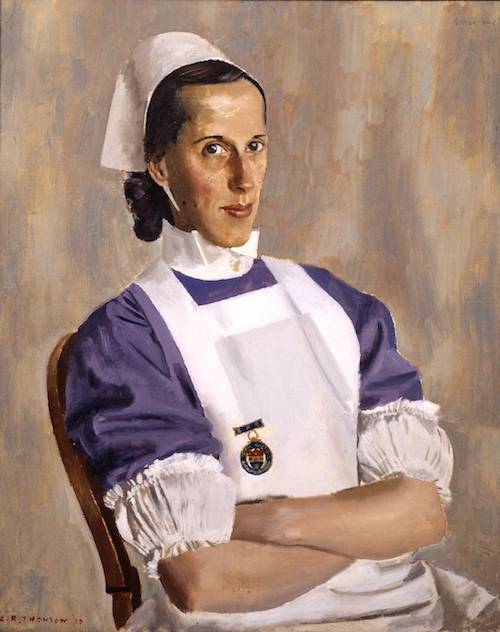
Sister Fry, 1939. She was the midwife who delivered Thomson’s first child.
But there is another advantage to sign language if you want to be an artist. Because thinking in Sign is not creating a sentence in words and then translating it into gestures. The whole grammar, the conceptual ideas which are possible and quite possibly the entire interior architecture of the brain ends up being different. And one of these key differences is that you think visually, in time and space. Children whose first language is Sign can describe rooms and places in far more detail than their hearing contemporaries, and from an early age.
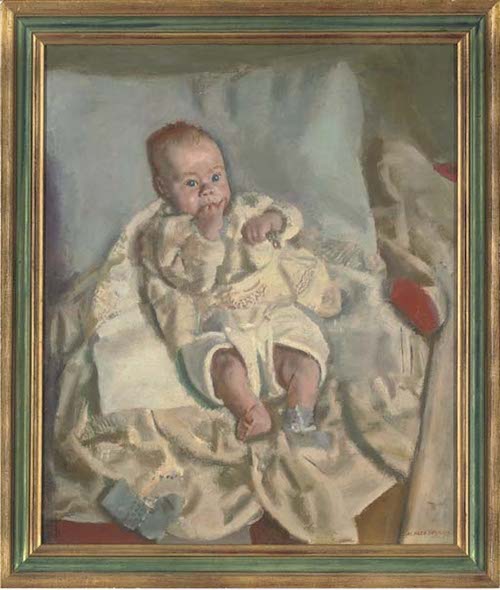
Thomson’s portrait of his infant son, Charles
So no wonder he turned to drawing and art. Between the wars, Thomson alternated between commercial work and fine art. (Along with, as the biography tells us in quite surprising detail, a great deal of drinking, louche clubs and pubs and shagging which goes to show that his deafness didn’t get in the way of his having a thoroughly bohemian lifestyle as well. My favourite anecdote is of him and Augustus John on a bar crawl in Marseilles, keeping themselves on the straight and narrow by only having one bottle of good champagne in each bar. That restraint wasn’t enough to stop them from being unable to perform with some women they picked up at the end of the evening. Really, there is quite a surprising amount of information in that book.)
Thomson was clearly a very successful commercial designer; the book constantly refers to how busy this kind of work kept him between the wars. Sadly it’s almost impossible to piece together much sense of who his clients were, apart from one reference to Three Nuns, Daimler, Barclays Bank and Bass (as ever, I would be in the eternal debt of anyone who can find me details of these posters). So pretty much all we know of this aspect of his work are these few railway posters and a single post-war design for London Transport along with a very small number of others.
While after the Second World War – in which he designed a number of Home Front posters as well as working as an official war artist – Thomson became a very successful portraitist, whose subjects included Lester Piggott, Churchill, Douglas Bader and the Queen.
Clearly the visual nature of deafness must, fairly often, transform itself into art. The prologue to Thomson’s biography gives an impressive list of deaf artists from the fifteenth century to the present, and Thomson himself was close friends with another deaf artist, Alexander Bilbin. But it could also be argued that his thought patterns gave him an even greater advantage when it came to posters. Because the whole language of a poster should be visual. As designers themselves tell us time and again, the message of a great poster should be immediately apparent through the images and the associations, not the words.
And how much easier is that to do if you yourself think in images?
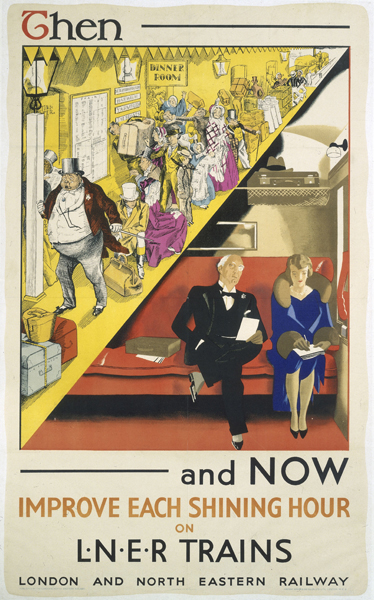
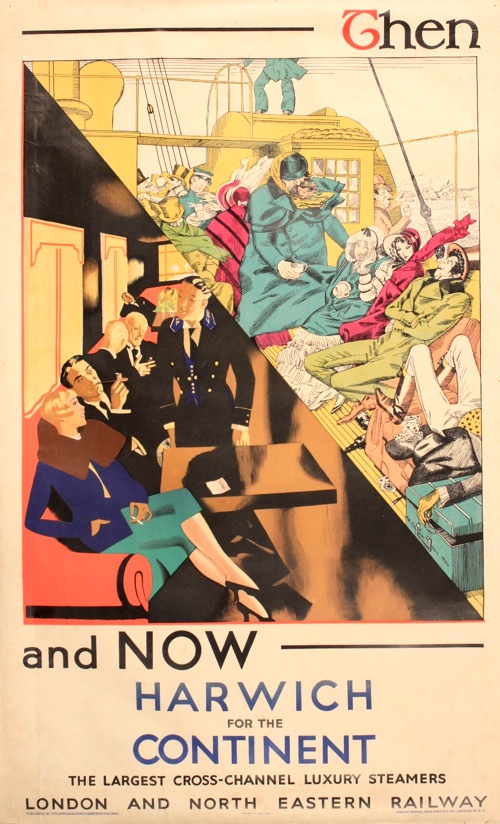
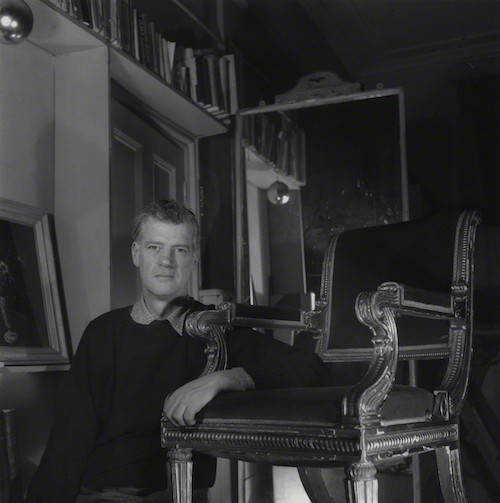

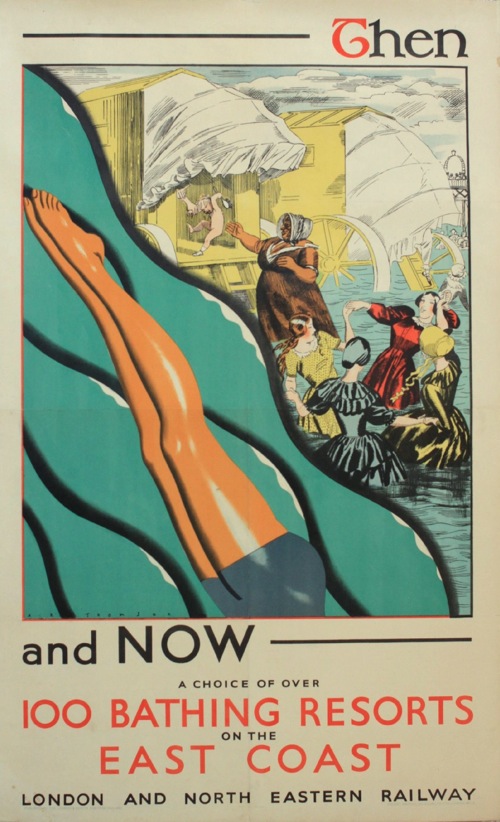
Fascinating in so many ways, I’m going to have another read soon, as I probably didn’t digest it all at once.
But, to go back to the beginning, what is improving each shining hour with the LNER – the trains, our brains or stomachs or clothing, or our disposition to the world. It does seem the least straightforwardly obvious meaning in the posters in the series, which all seemed to be showing “Progress” and the advancements in life and leisure in specifically named and shown ways.
It’s from an eighteenth century poem, that much Google has told me:
http://www.bartleby.com/360/1/77.html
But what I don’t know is why that bit of poetry is on that poster. It’s bothering me, too.
Well it’s the poem that is spoofed in Alice’s Adventures in Wonderland, so it would be pretty well known to the general observer, even if they didn’t know the original that well.
That original is also called Against Idleness and Mischief, maybe the posters images of comfortable leisure played against that.
How doth the little crocodile
Improve his shining tail,
And pour the waters of the Nile
On every golden scale!
How cheerfully he seems to grin,
How neatly spreads his claws,
And welcomes little fishes in
With gently smiling jaws!
Which is all very interesting but still doesn’t entirely explain what the poem is doing on the poster.
My current theory, looking at the poem again, is that it is the kind of thing learnt by small children, so perhaps the phrase is just one of those floating around in the collective consciousness?
Do you know if he signed his work A R or A R T ever as I have a painting of Lake Lucern – mis spelt – signed A R (Possibly there is a T under a brush stroke ) that looks like an advertising poster for a railway. It is VEry much his style , on a piece of wood in inches 16 x 12 ( so not a continental size)
Hi all
I am looking for any information on Alfred Reginald Thomson (1894 – 1979)
Do you know how many children he had and the name of his children ? also his wife’s name as I am trying to research his life work and paintings any information will be helpful.
Best regards
Tony
Do you have the biography of him? It’s called Tommy and is written by Arthur Dimmock. I can’t lay my hands on my copy at the moment, but that should have everything you need. The RNID may have a library which could help with that.